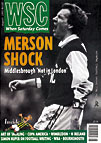 Xavier Wiggins reports on Wimbledon's lack of action as they search for a new home
Xavier Wiggins reports on Wimbledon's lack of action as they search for a new home
As followers of a team that have spent eleven consecutive years in the top flight, won the FA Cup and established themselves as formidable opponents, Wimbledon fans ought be envied by many other supporters. Closer examination, however reveals a club exiled from its own borough for the past seven seasons whose fans, whilst growing in number (a 115% increase since moving from Plough Lane) sit in a ground painted in the landlord’s colours, are stewarded by Palace fans and buy their merchandise in a shop where Wimbledon goods look like they have been put out by mistake. They even sup their pre-match beers in a bar called ‘Crystals’.
Common consensus among long-standing Wimbledon fans is that they would rather watch Third Division football in their own stadium in the borough of Merton than continue to be Premier League nomads with no prospect of a return home.
The exile is even harder to accept when several other League clubs have either just moved to new headquarters or are on the verge of doing so. For the likes of Sunderland, Bolton and Reading, the cooperation of the local council has been vital, borne out of a realization that a well-run football club can be a positive focus for a community. Yet for Merton Council it seems the fact that the football club plied its trade in Wimbledon for over a hundred years is of little importance.
The Dons’ current situation is complex. Sam Hammam’s preferred site is on land adjacent to a David Lloyd tennis and fitness centre in Raynes Park, which has good road access and is only two miles from Wimbledon town centre. The local council, meanwhile, has been conducting a feasibility study for a sports complex to be centred around the football club on a site currently occupied by Wimbledon Greyhound Stadium. This is just a couple of hundred yards from the spiritual home, Plough Lane. However, Sam Hammam, in his frequent conversations with supporters, says, “We will never play in a stadium where the fans are both behind glass and a greyhound track.” He is also against paying any sort of regular sum to Wembley Stadium plc, the current owners of the site.
The council are the villains in the eyes of many supporters, as Lawrence Lowne, coordinator of Wimbledon Independent Supporters Association (WISA) explains: “For the last few years Merton Council have voiced the idea that Wimbledon FC should return to Merton. It is time for words to be replaced by action. If the council are unable to deliver, they should step aside and let others who have the borough’s welfare at heart take over now.”
When the Dons left Wimbledon they were a quaint curiosity promoted beyond their level on crowds of seven thousand. Whether the Wimbledon public will accept the return of a club now looking to cement its place in the élite and averaging crowds of fifteen thousand remains to be seen. Nonetheless, WISA estimate that the construction of a suitable ground in Merton, such as on the site of the greyhound stadium, would create four hundred jobs and safeguard a further fifteen hundred in the locale.
The words of Kjell Inge Rokke can only be seen as encouraging. One of the club’s new Norwegian benefactors and a man who, if the tabloids are to be believed, caught so many fish that he was able to go on to build a £400 million financial empire, has said: “All supporters, not just Wimbledon fans, need to act to ensure that this very special club survives and prospers as one of football’s last real romantics.” Sam and the Norwegians need to stop talking of Dublin even as a last resort, though, while the council needs to continue their dialogue with the club. This has improved since the general election, which saw the area move entirely into Labour hands.
It will be no good our having been the inspiration for smaller clubs if the Wimbledon story ends with the club fighting a losing battle for its identity miles from home or even in a different country.
From WSC 126 August 1997. What was happening this month